|
|
| |
|
|
| |
|
|
|
|
| |
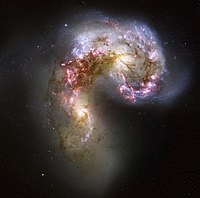 |
| The Antennae
Galaxies are undergoing a collision that will
result in their eventual merger. |
Galaxies
A galaxy is a group of many stars, along with gas, dust,
and dark matter. The name 'galaxy' is taken from the
Greek word galaxia meaning milky, a reference to our own
galaxy, the Milky Way.
Gravity holds galaxies together against the general
expansion of the universe. In effect, the expansion of
the universe takes place between groups of galaxies, not
inside those groups. This is because the mass of a
galaxy holds the galaxy together, and the same applies
to the groups of galaxies, such as our Local Group. The
gravitation is produced by the matter and energy in a
galaxy or group of galaxies. Everything in a galaxy
moves around a centre of mass, which is also an effect
of gravity.
There are various types of galaxies: elliptical, spiral
and lenticular galaxies, which can all be with or
without bars. Then there are irregular galaxies. All
galaxies exist inside the universe. There are probably
over 170 billion (1.7x1011) galaxies within the
observable universe. |
|
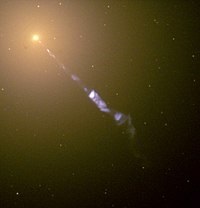 |
| A jet of particles
is being emitted from the core of the elliptical
radio galaxy M87. |
Description
There are galaxies of different sizes. Typical galaxies
range from dwarfs with as few as ten million (107) stars
up to giants with a hundred trillion (1014) stars, all
orbiting the galaxy's center of mass. Galaxies may
contain many multiple star systems, star clusters, and
various interstellar clouds. The Sun is one of the stars
in the Milky Way galaxy; the Solar System includes the
Earth and all the other objects that orbit the Sun.
Star clusters are not galaxies, they are inside
galaxies. Globular clusters are spherical tightly knit
balls of stars which are part of the outer halo of the
Milky Way. One of the largest (and oldest) known star
clusters, Messier 15, has several million stars, packed
closely together, with a black hole at its centre. The
stars are too closely packed to get an accurate count,
but it certainly has more stars than some of the smaller
galaxies.
Within galaxy clusters, galaxies move relative to other
galaxies. They can and do collide. When this happens,
the stars generally move past each other, but gas clouds
and dust interact, and can form a burst of new stars.
Gravity pulls both galaxies into somewhat new shapes,
forming bars, rings or tail-like structures.
Many galaxies also continue to form new generations of
stars. The Milky Way, and all spiral shaped galaxies
like it (see above image of NGC 2997), produce new stars
at a rate of one or two stars per year. These stars are
formed in the vast interstellar clouds that account for
about 1% to 10% of the mass of these galaxies. Globular
star clusters, on the other hand, are not currently
forming stars because this activity happened billions of
years ago and then stopped once all of the gas and dust
clouds were used up. |
|
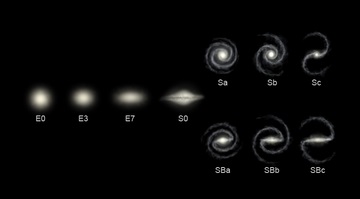 |
| Types of galaxies
according to the Hubble classification scheme:
an E indicates a type of elliptical galaxy; an S
is a spiral; and SB is a barred-spiral galaxy. |
Types of Galaxies
Galaxies come in three main types: ellipticals, spirals,
and irregulars. A slightly more extensive description of
galaxy types based on their appearance is given by the
Hubble sequence. Since the Hubble sequence is entirely
based upon visual morphological type, it may miss
certain important characteristics of galaxies such as
star formation rate in starburst galaxies and activity
in the cores of active galaxies.
Ellipticals
The Hubble classification system rates elliptical
galaxies on the basis of their ellipticity, ranging from
E0, being nearly spherical, up to E7, which is highly
elongated. These galaxies have an ellipsoidal profile,
giving them an elliptical appearance regardless of the
viewing angle. Their appearance shows little structure
and they typically have relatively little interstellar
matter. Consequently these galaxies also have a low
portion of open clusters and a reduced rate of new star
formation. Instead they are dominated by generally
older, more evolved stars that are orbiting the common
center of gravity in random directions. The stars
contain low abundances of heavy elements because star
formation ceases after the initial burst. In this sense
they have some similarity to the much smaller globular
clusters.
The largest galaxies are giant ellipticals. Many
elliptical galaxies are believed to form due to the
interaction of galaxies, resulting in a collision and
merger. They can grow to enormous sizes (compared to
spiral galaxies, for example), and giant elliptical
galaxies are often found near the core of large galaxy
clusters. Starburst galaxies are the result of such a
galactic collision that can result in the formation of
an elliptical galaxy. |
 |
| The Pinwheel Galaxy,
NGC 5457. |
Spirals
Spiral galaxies resemble spiraling pinwheels. Though the
stars and other visible material contained in such a
galaxy lie mostly on a plane, the majority of mass in
spiral galaxies exists in a roughly spherical halo of
dark matter that extends beyond the visible component,
as demonstrated by the universal rotation curve concept.
Spiral galaxies consist of a rotating disk of stars and
interstellar medium, along with a central bulge of
generally older stars. Extending outward from the bulge
are relatively bright arms. In the Hubble classification
scheme, spiral galaxies are listed as type S, followed
by a letter (a, b, or c) that indicates the degree of
tightness of the spiral arms and the size of the central
bulge. An Sa galaxy has tightly wound, poorly defined
arms and possesses a relatively large core region. At
the other extreme, an Sc galaxy has open, well-defined
arms and a small core region. A galaxy with poorly
defined arms is sometimes referred to as a flocculent
spiral galaxy; in contrast to the grand design spiral
galaxy that has prominent and well-defined spiral arms.
It appears the reason that some spiral galaxies are fat
and bulging while some are flat discs is because of how
fast they rotate.
In spiral galaxies, the spiral arms do have the shape of
approximate logarithmic spirals, a pattern that can be
theoretically shown to result from a disturbance in a
uniformly rotating mass of stars. Like the stars, the
spiral arms rotate around the center, but they do so
with constant angular velocity. The spiral arms are
thought to be areas of high-density matter, or "density
waves". As stars move through an arm, the space velocity
of each stellar system is modified by the gravitational
force of the higher density. (The velocity returns to
normal after the stars depart on the other side of the
arm.) This effect is akin to a "wave" of slowdowns
moving along a highway full of moving cars. The arms are
visible because the high density facilitates star
formation, and therefore they harbor many bright and
young stars.
A majority of spiral galaxies, including our own Milky
Way galaxy, have a linear, bar-shaped band of stars that
extends outward to either side of the core, then merges
into the spiral arm structure. In the Hubble
classification scheme, these are designated by an SB,
followed by a lower-case letter (a, b or c) that
indicates the form of the spiral arms (in the same
manner as the categorization of normal spiral galaxies).
Bars are thought to be temporary structures that can
occur as a result of a density wave radiating outward
from the core, or else due to a tidal interaction with
another galaxy. Many barred spiral galaxies are active,
possibly as a result of gas being channeled into the
core along the arms.
Our own galaxy, the Milky Way, is a large disk-shaped
barred-spiral galaxy about 30 kiloparsecs in diameter
and a kiloparsec thick. It contains about two hundred
billion (2×1011) stars and has a total mass of about six
hundred billion (6×1011) times the mass of the Sun. |
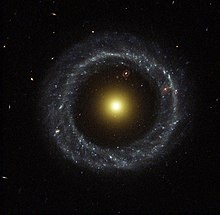 |
| Hoag's Object, an
example of a ring galaxy. |
Other morphologies
Peculiar galaxies are galactic formations that develop
unusual properties due to tidal interactions with other
galaxies. An example of this is the ring galaxy, which
possesses a ring-like structure of stars and
interstellar medium surrounding a bare core. A ring
galaxy is thought to occur when a smaller galaxy passes
through the core of a spiral galaxy. Such an event may
have affected the Andromeda Galaxy, as it displays a
multi-ring-like structure when viewed in infrared
radiation.
A lenticular galaxy is an intermediate form that has
properties of both elliptical and spiral galaxies. These
are categorized as Hubble type S0, and they possess
ill-defined spiral arms with an elliptical halo of
stars. (Barred lenticular galaxies receive Hubble
classification SB0.)
In addition to the classifications mentioned above,
there are a number of galaxies that can not be readily
classified into an elliptical or spiral morphology.
These are categorized as irregular galaxies. An Irr-I
galaxy has some structure but does not align cleanly
with the Hubble classification scheme. Irr-II galaxies
do not possess any structure that resembles a Hubble
classification, and may have been disrupted. Nearby
examples of (dwarf) irregular galaxies include the
Magellanic Clouds.
Dwarfs
Despite the prominence of large elliptical and spiral
galaxies, most galaxies in the Universe are dwarf
galaxies. These galaxies are relatively small when
compared with other galactic formations, being about one
hundredth the size of the Milky Way, containing only a
few billion stars. Ultra-compact dwarf galaxies have
recently been discovered that are only 100 parsecs
across.
Many dwarf galaxies may orbit a single larger galaxy;
the Milky Way has at least a dozen such satellites, with
an estimated 300–500 yet to be discovered. Dwarf
galaxies may also be classified as elliptical, spiral,
or irregular. Since small dwarf ellipticals bear little
resemblance to large ellipticals, they are often called
dwarf spheroidal galaxies instead.
A study of 27 Milky Way neighbors found that in all
dwarf galaxies, the central mass is approximately 10
million solar masses, regardless of whether the galaxy
has thousands or millions of stars. This has led to the
suggestion that galaxies are largely formed by dark
matter, and that the minimum size may indicate a form of
warm dark matter incapable of gravitational coalescence
on a smaller scale. |
|
Unusual dynamics and
activities
Interacting
Interactions between galaxies are relatively frequent,
and they can play an important role in galactic
evolution. Near misses between galaxies result in
warping distortions due to tidal interactions, and may
cause some exchange of gas and dust. Collisions occur
when two galaxies pass directly through each other and
have sufficient relative momentum not to merge. The
stars of interacting galaxies will usually not collide,
but the gas and dust within the two forms will interact,
sometimes triggering star formation. A collision can
severely distort the shape of the galaxies, forming
bars, rings or tail-like structures.
At the extreme of interactions are galactic mergers. In
this case the relative momentum of the two galaxies is
insufficient to allow the galaxies to pass through each
other. Instead, they gradually merge to form a single,
larger galaxy. Mergers can result in significant changes
to morphology, as compared to the original galaxies. In
the case where one of the galaxies is much more massive,
however, the result is known as cannibalism. In this
case the larger galaxy will remain relatively
undisturbed by the merger, while the smaller galaxy is
torn apart. The Milky Way galaxy is currently in the
process of cannibalizing the Sagittarius Dwarf
Elliptical Galaxy and the Canis Major Dwarf Galaxy. |
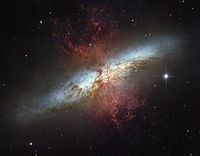 |
| M82, a starburst
galaxy that has ten times the star formation of
a "normal" galaxy. |
Starburst
Stars are created within galaxies from a reserve of cold
gas that forms into giant molecular clouds. Some
galaxies have been observed to form stars at an
exceptional rate, known as a starburst. Should they
continue to do so, however, they would consume their
reserve of gas in a time frame lower than the lifespan
of the galaxy. Hence starburst activity usually lasts
for only about ten million years, a relatively brief
period in the history of a galaxy. Starburst galaxies
were more common during the early history of the
Universe, and, at present, still contribute an estimated
15% to the total star production rate.
Starburst galaxies are characterized by dusty
concentrations of gas and the appearance of newly formed
stars, including massive stars that ionize the
surrounding clouds to create H II regions. These massive
stars produce supernova explosions, resulting in
expanding remnants that interact powerfully with the
surrounding gas. These outbursts trigger a chain
reaction of star building that spreads throughout the
gaseous region. Only when the available gas is nearly
consumed or dispersed does the starburst activity come
to an end.
Starbursts are often associated with merging or
interacting galaxies. The prototype example of such a
starburst-forming interaction is M82, which experienced
a close encounter with the larger M81. Irregular
galaxies often exhibit spaced knots of starburst
activity.
Active nucleus
A portion of the observable galaxies are classified as
active. That is, a significant portion of the total
energy output from the galaxy is emitted by a source
other than the stars, dust and interstellar medium.
The standard model for an active galactic nucleus is
based upon an accretion disc that forms around a
supermassive black hole (SMBH) at the core region. The
radiation from an active galactic nucleus results from
the gravitational energy of matter as it falls toward
the black hole from the disc. In about 10% of these
objects, a diametrically opposed pair of energetic jets
ejects particles from the core at velocities close to
the speed of light. The mechanism for producing these
jets is still not well understood.
Active galaxies that emit high-energy radiation in the
form of x-rays are classified as Seyfert galaxies or
quasars, depending on the luminosity. Blazars are
believed to be an active galaxy with a relativistic jet
that is pointed in the direction of Earth. A radio
galaxy emits radio frequencies from relativistic jets. A
unified model of these types of active galaxies explains
their differences based on the viewing angle of the
observer.
Possibly related to active galactic nuclei (as well as
starburst regions) are low-ionization nuclear
emission-line regions (LINERs). The emission from
LINER-type galaxies is dominated by weakly ionized
elements. Approximately one-third of nearby galaxies are
classified as containing LINER nuclei. |
|
|
|
|
|
|
|
|
|
|
|
|
|
|
|
|
|
|
Search Fun Easy English |
|
|
|
|
|
|
|
|
|
|
|
|
|
|
|
About
Contact
Copyright
Resources
Site Map |